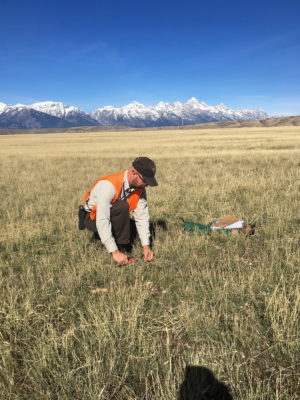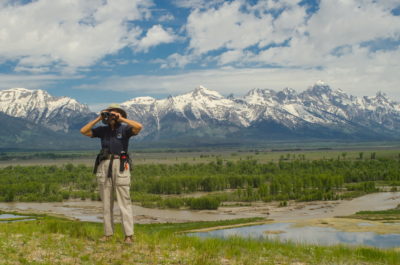As a child growing up amid a plethora of 1950s TV and movie Westerns, I longed to be a cowboy – regardless of my female gender. After all, I loved horses, and cowboys in the movies led a glamorous life, free to ride the range all day and bring bad guys to justice. It wasn’t until I reached adulthood that I realized how much difficult and tedious work cowboys perform. Mending fences, tending sick cows, working outside regardless of the weather, and wrestling with ornery horses did not fit their life portrayed in movies and TV.
Senior Years
In my senior years, however, after volunteering on wildlife refuges for over 10 years, I found myself romanticizing the life of a biologist, working with endangered species, making observations of wildlife, capturing and radio collaring animals. So a few years ago when Chuck & I were offered the opportunity to assist Eric Cole, the biologist at the National Elk Refuge in Jackson, Wyoming, we jumped at the chance.
As with movie cowboys versus actual cowboys, however, we have discovered that the glamour of the job is interspersed with hard work and occasional difficulties. “In some ways it has proved rewarding, and in some ways it is just a job like any other,” says Eric, who as a child played in the woods near the family home in one of the more sparsely populated counties in western Massachusetts.
Vital to a Refuge
“Biologists are vital to a refuge,” says Juliette Fernandez, Refuge Supervisor for U.S. Fish & Wildlife Service. “They are out on the lands monitoring the health and diversity of the resources we are charged with protecting. They are the eyes and ears for the various species and they ensure the natural pulse of a refuge continues to beat.”
Personality Driven
Biologists are personality driven, according to Sarah Bullock, biologist at Desert National Wildlife Refuge northwest of Las Vegas, Nevada. “Some like working at a desk; some like working outdoors,” she says. “I’m a little bit of both.”

This may be true of Eric Cole, as well, as he spends a good deal of time at his computer, but also heads to the field at any opportunity. “Seeing wolves regularly, being among thousands of elk, and watching the sun rise against the Tetons are experiences that many people would pay big money to have,” he says, “and I get to have them all the time.”
But Eric also enjoys the experience of long-term collaborative research projects coming together and publishing his results to add to the body of human knowledge.
Field Work
Even so, it seems that much of the field work is done by interns, volunteers, and seasonal workers, while the biologist is the planner. “Basically,” says Sarah Bullock, “biologists are paid to think and analyze. You’re the planner, generating different studies on how to accomplish goals and objectives of the Comprehensive Conservation Plan.” And as the biologist advances, the more respected he or she is as a depository of knowledge for their area.

So while Eric plans, we head to the Refuge to gather data for his work. Observing swans and tracking wolves is exciting and we always look forward to our day on the Refuge. All days are good days, but some are better than others.
The best days seem to fall on sunny, calm, warm days. We climb about a mile to the top of Miller Butte and observe the nesting swans or (later) the pairs and their cygnets. When we descend, we head deeper into the Refuge, to count ungulates, track wolves, and locate where Flat Creek stops flowing and descends underground. Some of the work involves trekking through dense underbrush and tall grasses to distant ponds that attract swans where we monitor their activity while observing other wildlife.
[twocol_one]

[/twocol_one] [twocol_one_last]

[/twocol_one_last]
Some days, however, prove more difficult than others since we also perform our biology work on rainy, windy, cold days. Huddling over observation records to keep them from blowing away and to keep them dry while we record data can be a challenge. And on those wetter days, the tall grasses tend to soak our clothes, and we emerge from the distant ponds soggy and shivering.
Glamour
Still, the experiences we encounter on all our biology days far outweigh any discomfort or inconvenience we must endure. The glamour is always there for us as wannabe biologists. And I’m sure it would have been for me as a cowboy years ago as well!

Thanks to Joe Lozar for the picture of Eric Cole.

